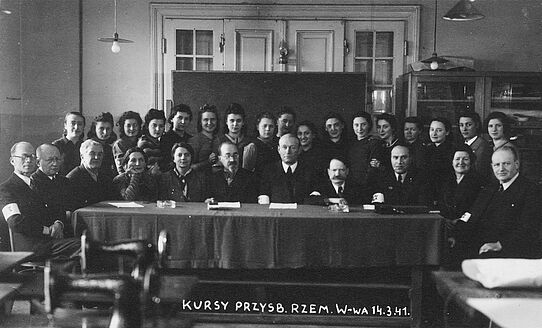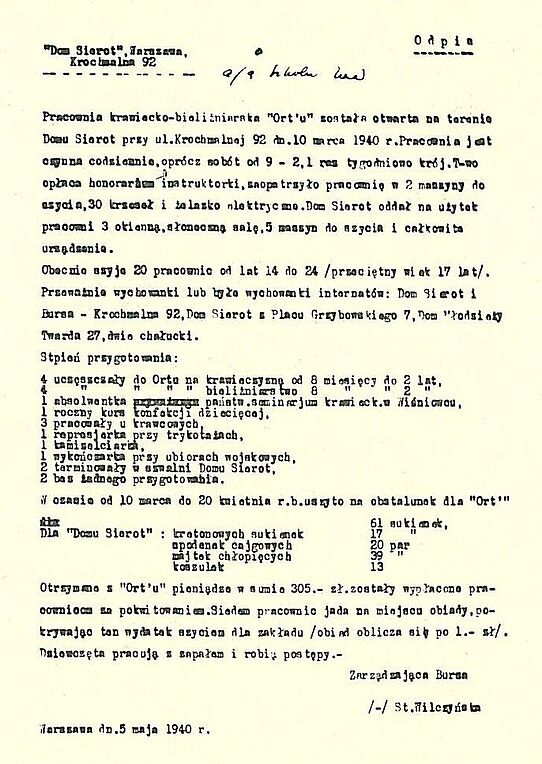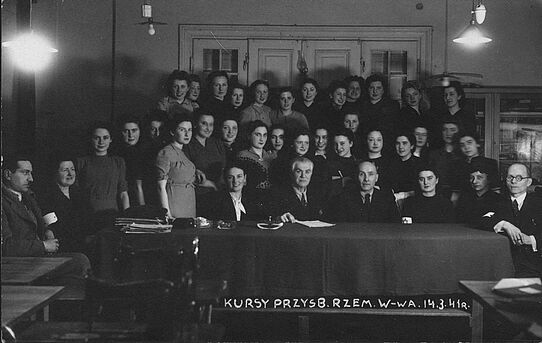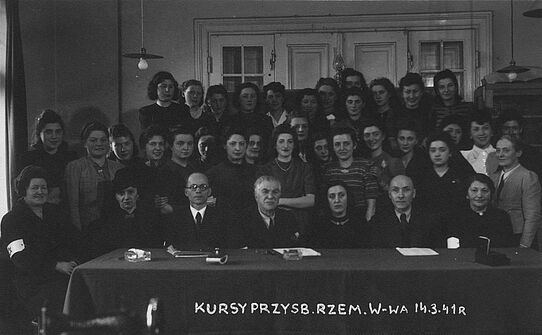ORT in the Warsaw Ghetto
ORT’s work in the newly independent Polish state started in 1921. Despite the political and economic turmoil of the 1930s Polish ORT developed very quickly. Immediately before the war in 1939 it ran 66 institutions and trained over 4,500 students.
![Commemorative plaque, Krochmalna Street [Korczak] Orphanage, Warsaw, Poland, 2008. Archive Photograph](/fileadmin/_processed_/2/e/csm_p08a036_crop_911aafe7b2.jpg)
During WWII ORT continued to work in the Warsaw ghetto, as well as in other Polish towns. In Warsaw ORT supplied craftsmen and workmen with the necessary machines, tools and raw materials to continue working. It provided not only sewing machines to tailors but also scissors, thread, needles, a bench to sit on and a table to work at. Much of this material was manufactured in the ORT workshops. Instruments were even provided to doctors and dentists.
In a 1948 report Mrs Rachel Gurman, for many years the secretary of the Central Committee of ORT in Poland who remained on the job until the eve of the revolt of the Warsaw ghetto and survived, indicates that
‘ORT was the first organization to start to build anew among the ruins. A few days after the German invasion, in October 1939, ORT left Zabia Street 9 and moved to other premises at Ogrodowa Street 3. The building at 29 Dluga Street that housed the vocational school and most of the ORT workshops and courses was completely bombed out. Shortly thereafter 200 machines hummed in the workshops and 250 persons were earning a living. It was important that ORT gave 250 persons a chance to make a living for themselves and their families; but it was even more important from the psychological point of view that a Jewish organization was able to start its work again.’
An ORT workshop for the manufacture of garments and underwear was opened in the Korczak orphanage at 92 Krochmalna Street, in March 1940.
An ORT workshop for the manufacture of garments and underwear was opened in the Korczak orphanage at 92 Krochmalna Street, in March 1940.


In mid-August 1940, ORT was officially authorised to open vocational courses and training workshops. When this was first announced, many lined up at dawn in front of the ORT offices to sign up for the courses. Workshops for locksmithing, carpentry, electrical installation, optics, car maintenance and driving, pastry-making, sewing, lingerie, fashion, ready-made clothes for children, knitting, glove-making and the manufacture of artificial flowers were initially opened. Later, courses were opened in chemistry, industrial design, typewriting, shorthand, accounting and agriculture. Between August 1940 and November 1941 one hundred and thirty-two groups attended ORT courses and enrolment totalled more than 5,000.
Rachel Gurman later recollected that ‘In ORT offices one could forget the nightmare of reality and find new courage to live; the offices became a kind of a literary and political circle. In addition to many teachers and instructors of various courses, other "habitués" who passed through Lezno Street, began to drop in for a chat and a glass of tea. This glass of tea had its history, too. Along with many other courses, ORT organized a course in pastry-making. It was Joint that distributed foodstuffs to hospitals, children's homes, etc., and it was from Joint that ORT received the sugar which was returned to Joint as candy. When I delivered to Joint the candy made by us, the good Mr. Winter, who was in charge of food supplies, always managed to give me some "rab" sugar. And that is why there was always a glass of tea in ORT, and that helped to make things cosy. Among our "habitués" were Dr. Ringelblum, Mrs Dora Simchovicz, several people from Lodz and many others whose names I no longer remember. We discussed politics or just chatted, and the horror that was all around us was forgotten... And to such an extent that it was a shock to hear about a new decree, beatings, murders, anti-Jewish measures... Then a bell announced the start of a lesson and we went back to our classes. There, one did not think about what was happening outside; there, it was all satisfaction and the joy of creating.’
An ORT identity card gave its bearer added protection and was supposed to protect one from deportation. According to Gurman ‘…indeed, after some round-ups, the Germans released a few ORT pupils, boys and girls. Whereas several persons were nabbed on the Lezno Street, no one ever entered the ORT premises at No. 13.’ Work continued despite growing deportations. Gurman recalls: ‘On 16 August, 1942 the ghetto area was still further reduced and ORT moved to smaller premises at 29, Gensza Street. Teaching permits were withdrawn, but ORT nevertheless continued its work. Garment and shoe workshops were opened; there were 15 machines and a very limited amount of tools and raw materials. These workshops served a double purpose: the workers were issued the so-called "life certificates" that were supposed to save the holder from deportation; on the other hand they helped clothe the Jews of the ghetto, for most of them had nothing but rags to wear. There was also a laundry supervised by Mrs. Kielbikowa. … Finally, and in spite of great difficulties, ORT managed to install two workshops, and their management was entrusted to Mr. S. Grinberg, who had been an ORT teacher for many years. …Once again ORT premises became a pleasant place to be in. In working one forgot the sad state of things.’

Work continued until the very last moment in April 1943, when the Warsaw Ghetto Uprising began and the ghetto was burnt down. Mrs Gurman ends her report, turned over to ORT in 1948, with the following words:
‘On January 18, 1943 J. Jaszunski, his wife, his son and his daughter-in-law were deported to Treblinka where all perished. A leader of Polish ORT for many years, J. Jaszunski continued his work during 1939/43 and remained at his post until the very last moment; until the very end he directed the entire activity of ORT. …It wasn't a secret to anybody that the ghetto's complete liquidation was scheduled for the spring of 1943. But ORT continued its activity. A hiding-place was arranged and there was always a guard at the door to warn the workers of the approach of danger, so that they could hide in the garret. But even under these conditions ORT remained a sort of an oasis; we sang while we worked, we read Sholem Aleichem. …Ester Goldenberg, a great actress from the Vilno company, often came to the workshop for a bit of a chat. On 15 April, 1943 "Letters of Menachem Mendel to Scheine Scheindel" were still read there and the audience laughed wholeheartedly… During the night of 18-19 April the ghetto was surrounded. The same night the revolt of the Warsaw ghetto flared up.’





